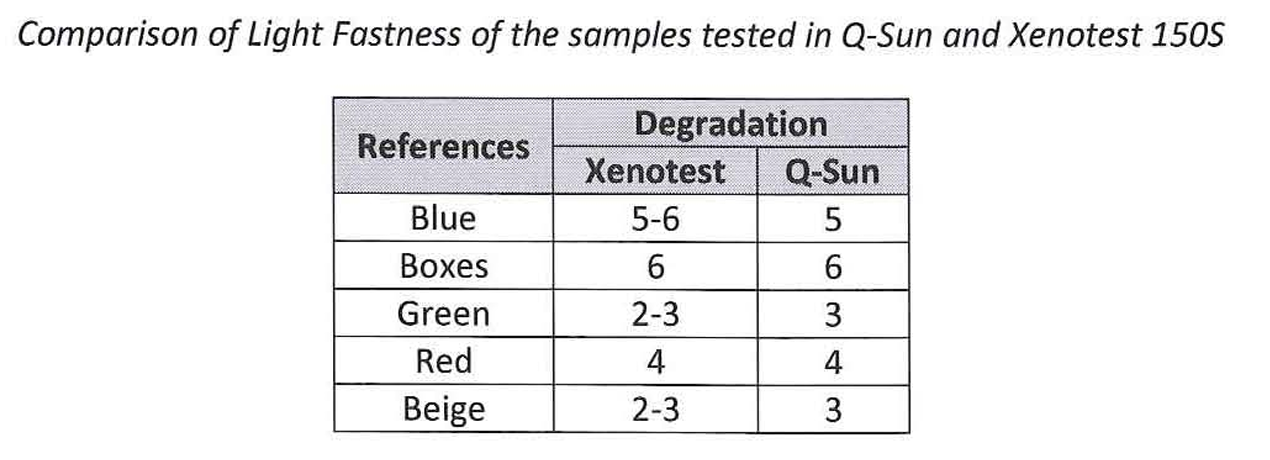LX-5033 - Q-SUN B02 vs Atlas Xenotest Evaluation
Last Updated 2011
Background
On October 9,2009, an agreement was signed between Q-LA8 CORPORATION, LUMAQUIN 5.A. and INTEXTER-UPC, to place a Q-5un Model 802 equipment in INTEXTER laboratory to test this unit regarding to the execution of light fastness test, according to ISO 105-802.
The initial assignment was set for six months, renewable depending on the interests of Q-LA8 or INTEXTER.
The apparatus was delivered to INTEXTER on October 23, 2009, and after the equipment installation the test starts from November 5, 2009.
BLOCKS OF TESTS PERFORMED
The implementation, adjustments and INTEXTER staff training, Mr. Juan A. Navarro and Ms. Begoiia Manzarraga, responsible for carrying out the tests, was done from 5 to 11 of November. Tests were started from November 10.
The tests to be developed were planned according to the request of INTEXTER costumers and/or the performance of round robin tests according to the quality certification program UNE-EN ISO / IEC 17025.
The first test block consists on the determination of artificial light fastness, according to ISO 105-802, of five fabric samples, previously studied in round robin national tests with the participation of INTEXTER and assuming the cost the INTEXTER laboratory.
Unfortunately, at the end of this first test block, the situation of the global economic crisis and with more intensity in the Catalan textile environment, resulted in no demand ofthis test during the first semester of 2010, so it was no possible to extend the comparative study between the Q-5UN 802 and the XENOTE5T 150-5 apparatus, given the high cost of this test.
TEST AND RESULTS
On November 10, 2009, a test comparing 5 fabric reference samples: Blue, Boxes, Green, Red and Beige, were carried out simultaneously in the Q-SUN B02 and in the Xenotest 1505 apparatus, according to the method 2 of ISO 105-B02. The test duration was extended until December 14,2009 in Q-SUN B02 apparatus and until December 17, 2009 in the Xenotest 1505.
Primarily, similar and consistent adjustments for black panel temperature (BPT) and relative humidity (RH), corresponding to normal conditions (colour fastness ofthe humidity test control: 5; maximum black standard temperature: 50 QC), were carried out in each apparatus.
The following table shows the conditions selected for testing in each apparatus:

Humidity was controlled using the test control fabric indicated in ISO 105 B02. Two test control fabric were used during the test. The first humidity test control fabric was used from November, 10, 2009 until November 18, 2009, and the second control was carried out from November 18, 2009 to December 14, 2009. The total exposure times were 121 and 174 hours, respectively. In both cases, a rating of 5 (see attached samples), according to Blue Wool Standard Scale, were obtained corroborating the adequate effective humidity of the chamber.
The results of light fastness using the method 2 of ISO 105-B02 obtained for each apparatus are shown in the following table:

DISCUSSION AND CONCLUSIONS
Various aspects regarding to both the handling properties and the light fastness results obtained are discussed below for each type of apparatus:
- Considering that during testing is necessary to carry out regular visual observations of the levels of degradation of the exposed samples and/or the colour fastness ratings using the Blue Wool Standard scales, the person accustomed to performing these tests on other apparatus did not observed significant differences regarding to the convenience to handling the samples and not either into the process of entry and exit the specimens from the cabinet camera not for the process of remotion of the opaque covers.
- Obtaining and maintenance of black standard temperature and effective humidity conditions of the cabinet did not show any complication. Neither was it observed difficulties or excessively long recovery times of the exposure conditions at the beginning of the test not during the intermediate stops to observe the specimens. Also, the reproducibility of the effective humidity conditions was demonstrated by comparing the humidity control 1 and control 2.
- No significant difference in the BPT or in the order of magnitude of the exposure time required to obtain similar levels of colour degradation, taking into account the difference between the Q-Sun B02 apparatus, where the specimens are continuously exposed to light, and the Xenotest 150S, in which specimens are exposed of intermittent form to light for each rotation of the specimen holders.
- The colour fastness ratings, using the Blue Wool Standard Scale, determined for the specimens tested are similar independently the apparatus used. The colour fastness ratings differences were situated within Y, point, which is the accepted tolerance of the visual assessment, both as regards of reproducibility of the test and of the accuracy of visual assessment between different observers.
- Taking into account that the five samples tested cover a range of colour fastness rating of the Blue Wool scale from 2 to 6, the Y, difference of evaluation between the two apparatus did not notice any systematic bias in favour of one or the other apparatus, which would indicate a statistically random oscillation around the mean, within the limits of accuracy of visual assessment system itself. This statement confirms the earlier conclusion.
To sum up, from the results of this test it can be concluded that not detected difficulties or negative aspect that could limit or prevent the production of reproducible and accurate results in testing artificial light fastness with xenon arc fading lamp test, according to ISO 105 B02 Method 2, with the Q-Sun model B02 apparatus, despite being able to conduct the test with a limited number of samples.